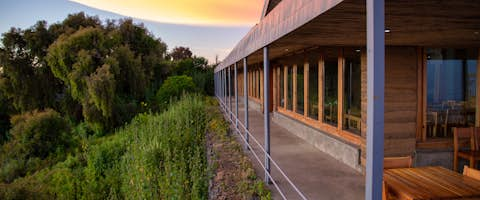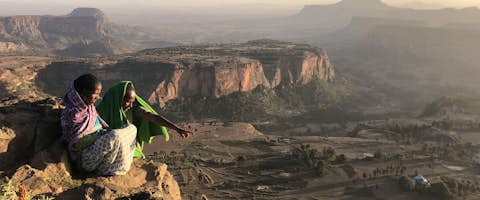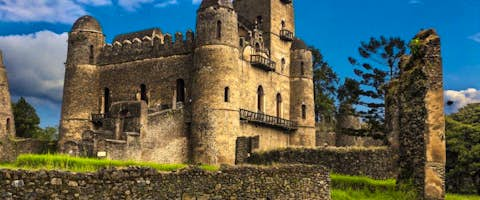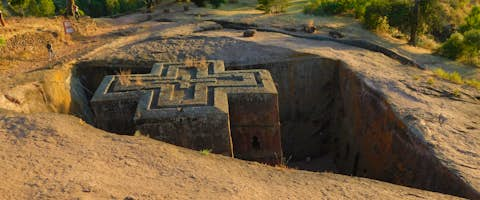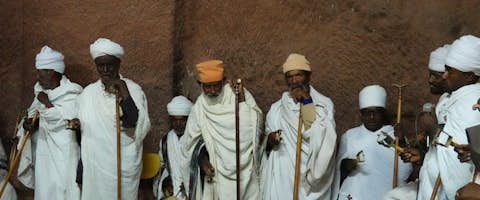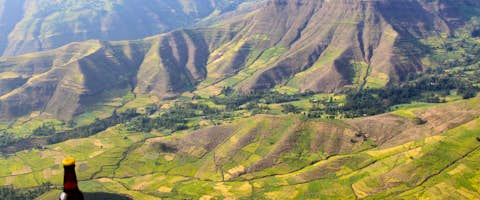The Story of Yemrehana Krestos
Yemrehana Krestos was also built up to 80 years before the rock-hewn churches in central Lalibela.
Unlike the churches in the centre of town, Yemrehana Krestos was not excavated from the rock face, having been built more conventionally. It was constructed from layers of stone and wood panels, expertly designed to prevent the monastery from sinking into the marshy ground beneath. This design contributes to the monastery’s characterful aesthetic.
The gravitas of the church is enhanced by its location. Situated in a cave whose roof was formed by basalt lava flows, the monastery is shrouded in darkness, granting it a solemn and somewhat bewitching atmosphere. This cave is itself is surrounded by juniper trees, where vervet monkeys are sometimes found.
The interior of the church is spectacularly ornate, the walls of the church display carved geometric designs and colourful murals portraying various biblical scenes. It is very well-preserved, although there are a few structural problems that have developed over the years. Thankfully, many of these are being dealt with thanks to a grant from the U.S. State Department Ambassadors Fund for Cultural Preservation (AFCP).
Like most ancient churches in Ethiopia, Yemrehana Krestos is still in use today. There is something quite fascinating - and often deeply moving - about witnessing this more than 800 year-long continuity in religious practice and heritage.
Yemrehana Krestos is one of a group of churches found in the highlands around Lalibela. The other major churches in these highlands are Asheton Maryam and Na’akuto La‘ab Monastery.
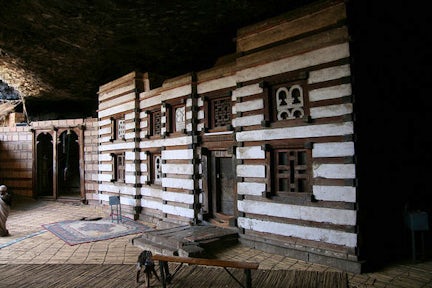
Yemrehana Krestos Church FAQs
-
How do I get there?
If coming from Addis Ababa, there is a direct flight to Lalibela that takes less than an hour.
Once in Lalibela, Yemrehana Krestos can be reached by a 1.5-hour drive by 4WD. It is also possible to reach it by foot or mule. Both options take around five hours and the routes offer incredible scenery throughout.
-
Accommodation in Lalibela
The increased popularity of Lalibela in recent years has led to the development of a number of good hotels and lodges, catering to different budgets. Several are lodges constructed in a traditional stone and thatched-roof style, but boasting modern amenities, and offering excellent views.
-
When is the best time to visit?
The dry season in Ethiopia runs between October and March, so this is generally the best window to visit Ethiopia, although Lalibela can be visited year-round.
Lalibela is the religious epicentre of Ethiopia, and it is the best place to be for many of the festivals on the Ethiopian Calendar. The festivals of Timkat and Ethiopian Christmas both take place in January.
Visit Yemrehana Krestos on these trips
Ready to plan your Ethiopia adventure?
Listen
We'll spend some time listening to your aspirations, then discuss the kind of experience that might suit you.
Match
Next we'll discuss the options, shortlist the best trips for you and present you our impartial recommendations.
Reserve
We'll place a 24 hour hold on your preferred option - without obligation - whilst we talk through the details.
Whatever your budget, group size, length of stay, preferred activity or appetite for adventure, we can help.
+1 315 645 2889


